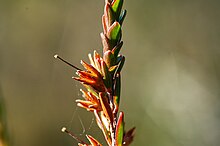| Epacris corymbiflora | |
|---|---|

| |
| In Mount Field National Park | |
| Scientific classification | |
| Kingdom: | Plantae |
| Clade: | Tracheophytes |
| Clade: | Angiosperms |
| Clade: | Eudicots |
| Clade: | Asterids |
| Order: | Ericales |
| Family: | Ericaceae |
| Genus: | Epacris |
| Species: | E. corymbiflora |
| Binomial name | |
| Epacris corymbiflora Hook.f. | |

Epacris corymbiflora is a species of flowering plant in the heath family, Ericaceae, and is endemic to Tasmania. It is a low, spreading shrub with elliptic leaves and white, tube-shaped flowers.
Description
Epacris corymbiflora is a spreading shrub that grows up to 30 cm (12 in) high and 60 cm (24 in) wide. The leaves are crowded, elliptic or diamond-shaped, 3–4 mm (0.12–0.16 in) long with a small point on the tip and the edges curved upwards. Both sides of the leaves are green and there are a few more or less parallel veins. Flowering occurs in summer and the flowers are arranged in dense, more or less spherical groups near the ends of branches, each flower tube-shaped, white and about 5 mm (0.20 in) in diameter.
Taxonomy and naming
Epacris corymbiflora was first formally described in 1857 by Joseph Dalton Hooker in The botany of the Antarctic voyage of H.M. Discovery ships Erebus and Terror. III. Flora Tasmaniae from specimens collected near the Franklin River in Macquarie Harbour by Ronald Campbell Gunn.
Distribution and habitat
This epacris is common in moorland environments and button grass heath in near-coastal areas of Tasmania.
Use in horticulture
Epacris corymbiflora grows well in containers or pots due to its excellent capacity as a dwarf species. The seed of some strains exhibits a dormancy stage that is reportedly overcome by storage in a dark place for 3–6 months. If using the bog method, seed should be spread over the surface of the propagation mixture. If such medium is kept constantly moist, germination should occur within 10–20 weeks.
References
- "Epacris corymbiflora". Australian Plant Census. Retrieved 4 May 2022.
- ^ Jordan, Greg. "Epacris corymbiflora". University of Tasmania. Retrieved 5 May 2022.
- ^ "Epacridaceae Epacris corymbiflora". UTAS Plant Science. Retrieved 27 November 2019.
- ^ "Epacris corymbiflora". Alpine Garden Society. Retrieved 5 May 2022.
- "Epacris corymbiflora". APNI. Retrieved 4 May 2022.
- Hooker, Joseph D. (1857). The botany of the Antarctic voyage of H.M. discovery ships Erebus and Terror in the Years 1839-1843 :under the command of Captain Sir James Clark Ross. Vol. 3. London: Reeve Brothers. p. 261. Retrieved 4 May 2022.
| Taxon identifiers | |
|---|---|
| Epacris corymbiflora | |